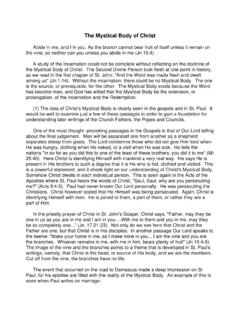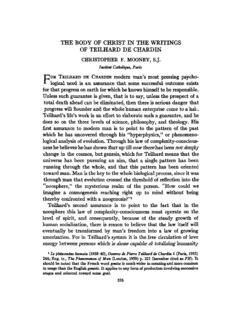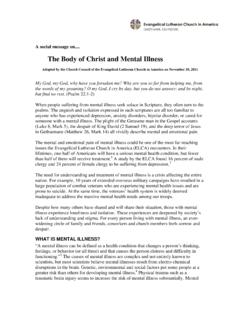Transcription of Clothing the Body of Christ: An Inquiry about the Letters ...
1 Martin F. Connell Clothing the body of christ : An Inquiry about the Letters of Paul The motto of the school where I teach Saint John's University in Collegeville, Minnesota is Induamur arma luc s, Saint Jerome's late fourth-century Latin rendering of Saint Paul's first-century Greek invitation,1 "Let us put on the armor of light!" (Rom 13:14), more literally, "Let us clothe ourselves with the armor of light!"2. The invitation was part of the foundation of Saint John's Abbey when Benedictines ventured before the Civil War from Saint Vincent's Abbey in Latrobe, Pennsylvania to the Upper Mid- west, where monks of Bavarian origins founded the school and dedicated themselves to educating poor, German Catholics in the spare farming region of nineteenth-century central As some areas of Minnesota had already been occupied and settled by national communities of Lutherans Swedes, Norwegians, Finns, whose churches maintained the languages and customs of their ancestors the pioneering monks ventured to a place just west of Saint Cloud, where the Benedictine monks were readily distinguishable in their black, hooded habits.
2 While in Europe at Martin F. Connell teaches at Saint John's University in Collegeville, Minnesota. 1. Biblia Sacra iuxta vulgatam versionem, ed. Bonifatio Fischer, Iohanne Gribomont, Sparks, and W. Thiele, 3rd edition (Stuttgart: Deutsche Bibelgesellschaft 1983) 1765. An English cognate, "ind ment," of the Latin word indumentum was used in the fifteenth through seventeenth centuries, and for a little longer in the scientific disciplines of zoology and botany. See "ind ment,". Oxford English Dictionary, 2nd edition (Oxford University Press 1989); Alcuin Library, Saint John's University, 16 March 2010; to "ind ment," with etymology, citations, and date chart. 2. 1 thank Paul F. Bradshaw, Maxwell E. Johnson, Kimberly Belcher, the Minne- sota regional group of the North American Academy of Liturgy (Luther Semi- nary, Saint Paul, 29 October 2009), and the members of the Early Liturgy Seminar of the NAAL meeting (Milwaukee, 9 January 2010), who reviewed this essay and offered assessment and criticism.
3 3. See Colman J. Barry, Worship and Work: Saint John's Abbey and University, 1856-1992, third edition (Collegeville, MN: Liturgical Press 1994) 3-24. Martin F. Connell 128. the time of Martin Luther and the Reformation, Catholicism had been the Christian foundation and reforming Protestants the alarming novelty, in America the opposite was often the case, with Protestants at first Puritans, then Anglicans, Lutherans, Presby- terians, Methodists, and Baptists as the Christian foundation and Roman Catholics the social A significant marker of social change in the religious landscape was Clothing ; the habits of monks, nuns, and priests signaled a new kind of Christianity, a consolation to pioneering German Catholics in Minnesota, a fright, perhaps, to Lutherans who had preceded them to the territory.
4 That the monks chose Induamur arma luc s, "Let us clothe ourselves with the armor of light/7 as the motto might have signaled their charge in the face of Protestant Americans. In a life cloistered from the established cultures, the monastic cowls hollered in silence, "We are here; we are Christian;. we are not like you/' Clothing did that there and then as it does here and now, in religious and secular societies, marking people as alike and different by the similarities and dissimilarities of the styles, fabrics, and colors of their dress. In four decades of the reform of Roman Catholic worship after Vatican II, even as many Christian communities maintain distinc- tive Clothing for ministers and new members, virtually no critical attention has been accorded the New Testament witness about Jesus' or the first-century church's It's a striking lacuna, for Clothing is omnipresent in the New Testament, from the depic- tion of John the Baptist a few chapters into the canon "John wore a garment of camel's hair and a leather girdle around his waist".
5 (Matt 3:4) to him who sat upon the white horse "clad in a robe dipped in blood" a few chapters from the canon's end (Rev 19:13). Ignorance about Clothing in the theological academy is not sur- prising in some ways, because for a long time studies have gener- ally assumed that no ritual vesture was employed in the first few 4. Roger Finke and Rodney Stark, The Churching of Amenca, 1776-2005: Winners and Losers in Our Religious Economy (New Brunswick, NJ: Rutgers UP 2006), espe- cially "The Coming of the Catholics, 1850-1926": 117-55. 5. Only four of the 9,100 pages of the Theological Dictionary of the New Testament, ed. Gerhard Kittel (Grand Rapids: Eerdmans i9 4ff.) are accorded the theology of Clothing in the New Testament; see Albrecht Oepke, vol.
6 2 (1964) 318-21. Clothing the body of christ 129. centuries of Christianity: "There is one thing quite certain: at the beginning of the Christian era there were no sacred vestments at all, that is, no garments, whether of ordinary or special form, blessed and set aside for liturgical use.. It would be entirely fanciful to suppose that at the 'breaking of Bread' mentioned in Acts and elsewhere full modern ritual, whether East or West, was employed, or special vestments still less those of modern type! were worn/' 6 Such certitude about any issue regarding worship in antiquity piques suspicion, resulting in this reading of the scrip . tures for contrary evidence, particularly in the early stratum of Christian worship, the writings of the New Testament and, from there, in this Inquiry , the earliest of that early stratum: the Letters of Saint Paul.
7 Although the total number of verses the apostle wrote about Clothing are fewer in number than those he wrote about Baptism or the Lord's Supper, Paul wrote more often of Clothing than of those rites. 7. Clothing IN THE GOSPELS. This fledgling consideration of Clothing in Paul's writings is also stirred up by how often the evangelists described and then amended details of Jesus' Clothing , revelatory in at least two ways. The first way is when the same narrative is carried from one evan . gelist to another, and in the later version the garment is either changed or described differently. This is manifest, for example, in the synoptic narratives of the Transfiguration, in which the garment of Jesus, the , is identical in all of Matthew, Mark, and Luke, as is its color, white.
8 Yet the evangelists modified how the garment is whitened or what quality the "white" of Jesus'. Clothing had. Mark wrote that Jesus' "garments became glistening, intensely white, as no fuller on earth could bleach them" (9:3), a close description of the laundering process that would be odd if Clothing had had no relevance to the community for which he 6. Raymund James, "The First Appearance of Christian Vestments," Orate Fratres 12 (1938) 113-22, here at 114, with capitalization, punctuation (save the ellipsis) and italics as in original. 7. He wrote of Baptism in three Letters Romans, Galatians, and 1 Corinthians and of the Lord's Supper in one, 1 Corinthians, but he wrote of Clothing in five of the seven Letters : Romans, 1 Corinthians, 2 Corinthians, Galatians, and 1 Thessa- lonians.
9 There are no baptism or Clothing references in Philippians or Philemon. Martin R Connell 130. wrote. Matthew described that Jesus' "garments became white as light" (17:2), and, for his version, Luke describes the garment as "dazzling white" (9:29). One must at least entertain that each author edited the descriptions based on what he experienced of Clothing in the community in which his Gospel would be proclaimed. The second way is when in the same basic gospel narrative particular garments are different. This is so in a few stories, but most readily apparent in the empty-tomb narratives of the synoptic gospels, in which those announcing at the tomb that Jesus is risen wear a garment unique to that gospel. In the Gospel of Mark (16:5), for example, one finds "a young man sitting on the right side, dressed in a white stole" ( ).
10 In antiquity the "stole". of Mark meant a "long, flowing robe," "equipment," or "dress for battle." 8. Matthew has not a young man at the tomb, but an angel, whose "appearance was like lightening, and his raiment white as snow". (28:3),9 "raiment" translating , a change from Mark's "stole." 10 Matthew's "raiment" was more generic than Mark's "stole," since comes from , with the root (-du-). meaning "garment," and the prefix (en-) meaning "on.". Finally, in Luke (24:4), one finds neither Mark's young man nor Matthew's angel, but "two men" at the tomb dressed in "dazzling apparel" ( ).11 The qualifier, "dazzling," is uniquely Lukan and used only twice, here at the empty tomb and as a description of the kind of white garment worn by Jesus at the Transfiguration, "dazzling white.














